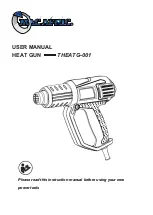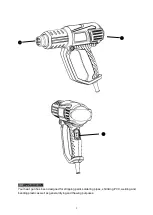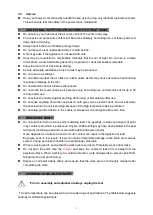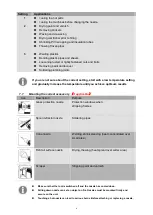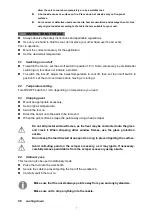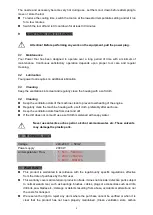
7
allow the unit to cool down completely or use a suitable tool.
A hot nozzle can set a surface on fire. Place down hot nozzles only on fire-proof
surfaces.
An incorrect or defective nozzle can lead to heat accumulation and damage the unit. Use
only original nozzles according to the table that are suitable for your unit.
8
INSTRUCTIONS FOR USE
Always observe the safety instructions and applicable regulations.
Use only one hand to hold the tool, do not place your other hand over the air vents
Prior to operation :
Mount the correct accessory for the application.
Set the desired air temperature.
8.1
Switching on and off
To switch the tool on, set the on/off switch to position 1/2/3. Some smoke may be emitted after
switching on; this does not indicate a problem.
To switch the tool off, adjust the lowest temperature to cool off, then set the on/off switch to
position 0. Let the tool cool down before moving or storing it.
8.2
Temperature setting.
Turn ON/OFF switch to 1/2/3, depending on temperature you need.
8.3
Stripping paint
Mount an appropriate accessory.
Set a high air temperature.
Switch the tool on.
Direct the hot air onto the paint to be removed.
When the paint softens, scrape the paint away using a hand scraper.
Do not strip metal window frames, as the heat may be conducted onto the glass
and crack it. When stripping other window frames, use the glass protection
nozzle.
Do not keep the tool directed at one spot too long to prevent igniting the surface.
Avoid collecting paint on the scraper accessory, as it may ignite. If necessary,
carefully remove paint debris from the scraper accessory using a knife.
8.4
Stationary use
This tool can also be used in stationary mode.
Place the tool onto the workbench.
Secure the cable to prevent pulling the tool off the workbench.
Carefully switch the tool on.
Make sure that the nozzle always points away from you and any bystanders.
Make sure not to drop anything into the nozzle.
8.5
cooling down

